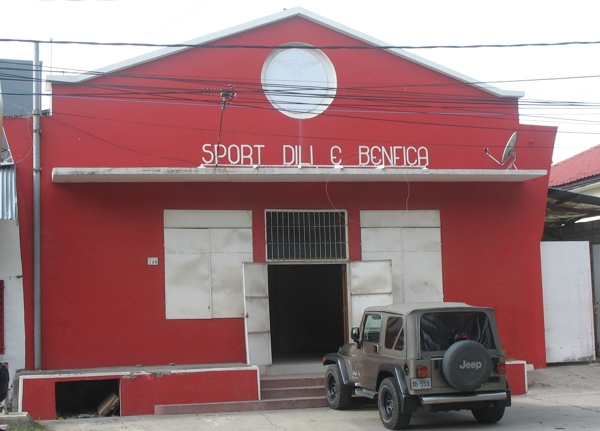In the second of our reports on 2016 archival developments, we report on the fragile circumstances surrounding the Max Stahl Audiovisual Archive Center for Timor Leste (CAMSTL) and the need for urgent action by all concerned parties.
![Difficult times - but still working. Max Stahl with CAMST-L staff Gilberto and Eddy Paraujo. [Source: CAMSTL]](https://timorarchives.info/wp-content/uploads/2016/04/camstl-fb-staff.jpg?w=450)
Difficult times – but still working. Max Stahl with CAMSTL staff Gilberto Neves and Eddy Paraujo. [Source: CAMSTL]
When we visited CAMSTL in 2015, we reported optimistically on the institution’s future. Newly equipped with government-funded, high-cost digital audiovisual preservation systems and awaiting completion of a dedicated building, CAMSTL’s founder, Max Stahl, could see the emergence of Timor-Leste’s national audiovisual archive.
Sadly, these optimistic prospects are now in trouble. The immediate sign of this is a cessation of Timor-Leste Government funding. In the absence of any specific statement from the parties, the reasons for the funding cessation are difficult to determine.
Possible factors
It is known that some in government circles are asking the question: Who owns the CAMSTL collection and what is Timor-Leste getting from its funding of the archive?
Another likely factor in the current situation is the status of the new audiovisual building attached to the Resistance Archive and Museum (AMRT). Originally envisaged for housing CAMSTL, there are signs that a move to the building may be conditional on some form of merger with the AMRT. Given the continuing strong official commitment to AMRT, the merging of CAMSTL with AMRT on one building site might seem simultaneously helpful to CAMSTL and financially attractive to government.
Whatever the reasons, there is evidently a communication breakdown between CAMSTL and the Government.

Current CAMSTL-occupied building. Barely fit for audiovisual archives.
Comment
The CAMSTL collection and ongoing work is of inestimable value to Timor-Leste. Protection of the integrity of the collection and access to it for historical, educational and community purposes is paramount.
Whatever the actual reasons for the funding cessation, the current situation is untenable. The future of the collection is at risk and CAMSTL needs at least some bridging finance to maintain basic functions until the problems are resolved. It also needs an urgent improvement to storage and working conditions; the present building seems to us quite unfit for audiovisual archive purposes.
There appears to be some mutual lack of confidence between CAMSTL and the Government. Both parties have a responsibility to do all they can to correct this. Perhaps finding a mutually agreeable mediator will help re-establish understanding and communication between the parties.
The centrality of Max Stahl to CAMSTL is both its strength and a prospective weakness. He has somewhat single-handedly driven the development of this high-value archive and he has trained many East Timorese in archival and audiovisual processes and production. However, it seems evident that the institutional basis of CAMSTL, especially its management structure, needs to be expanded and consolidated. The present difficulties are amplified by Max’s continuing health condition.
Despite the possible administrative attraction to government of merging CAMSTL with AMRT, this needs very cautious consideration. The 2016 edition of UNESCO’s authoritative Audiovisual Archiving: Philosophy and Principles draws attention to the particularly difficult technological and management challenges of audiovisual archives. In the area of governance, it recommends on the basis of international experience, semi-autonomy of the audiovisual archive as a desirable minimum (our emphasis).*
Given our knowledge of the present management styles at AMRT and CAMSTL, we doubt they could work easily together and a ‘forced’ merger would likely fail. We also doubt AMRT, by itself, currently has the range of expertise to successfully manage the CAMSTL collection and program. While the pre-independence historical materials at CAMSTL are relevant to the resistance theme, much of the post-1999 material seems to be outside the Resistance Archive’s collection purpose and mandate.
We can envisage one practical interim solution: the relocation of CAMSTL into the AMRT-connected, newly-constructed audiovisual building. The two institutions could perhaps share some facilities in common but with each institution retaining separate identities and management systems.
Sooner or later, however, Timor-Leste will need to establish a dedicated, technically specialised national audio-visual archive. In addition to holding nationally significant audio-visual materials, such an institution could provide guidance and assistance to other institutions with fragile materials. Given the specialised work and systems already established at CAMSTL, it is a prime candidate for becoming a distinct national institution.
Resolving the current difficulties is an urgent priority for all concerned. We urge that all parties keep in mind the immense value of the CAMSTL collection and program to present and future generations of Timor-Leste’s citizens .
—————
* See Section 4.7 Governance and autonomy, pages 49-51.
Background info:
CAMSTL Website (on Facebook).
CHART’s CAMSTL Page
Cafe Pacific/David Robie 2014 backgrounder

You have footage that you are not aware of that they need to disappear.